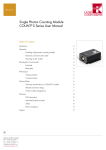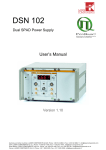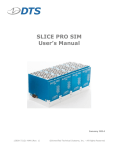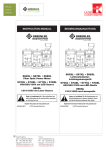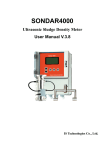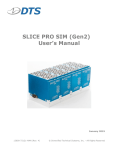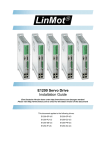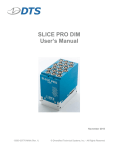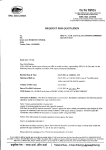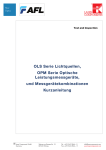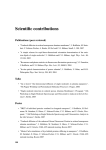Download Series - User Manual
Transcript
Detectors Single Photon Counting Module COUNT®-Series User Manual Table of Contents Introduction2 Operation2 Handling single photon counting modules 2 Electrical connections (rear side) 3 Powering up the module 3 Optimizing performance 3 Mounting the Count-Module 4 Front-side4 Base plate 4 Performance5 Spectral response 5 Timing resolution 5 Correction factor 6 Technical Data 7 Technical Specifications for COUNT® module 7 Technical Specifications for COUNT BLUE module 8 Technical Specifications for COUNT® NIR module 9 Absolute Maximum Ratings 10 Interface information 10 Product number designations 10 ® Support11 1 Germany & Other Countries Laser Components GmbH Tel: +49 8142 2864 – 0 Fax: +49 8142 2864 – 11 [email protected] www.lasercomponents.com Detectors Single Photon Counting Module COUNT®-Series - User Manual Introduction Laser Components’ COUNT® series of single photon counting modules has been developed to offer a unique combination of high photon detection efficiency, wide dynamic range and ease of use for photon counting applications. Combining Laser Components’ ultra-low—noise VLoK silicon avalanche photodiode with specially developed quenching and signal processing electronics, the module offers everything needed for single photon detection from 400 – 1000 nm. Incoming photons generate corresponding electrical pulses which may be conveniently read out at the TTL output. The optional FC connector provides a convenient method for connecting the module to the sample using a multimode optical fiber. Operation Handling single photon counting modules The avalanche photon diode inside the COUNT® is an extremely sensitive device. It can be permanently damaged by over-exposure to intense light. The COUNT® contains a high voltage supply. Users may be injured if the case is opened. All internal settings are pre-set; there are no user adjustments necessary. Opening the case will invalidate the warranty. Excessive light level (e.g. daylight) might damage a powered COUNT®. Precautions should be taken to avoid such situations or, alternatively, to monitor the count rate and eventually shut down the power to the COUNT® using e. g. the DSN102 from PicoQuant GmbH. When the COUNT® detector is mounted on another instrument, ensure that the optical connection is light-tight. Handle the COUNT® detector with care. Do not drop it or expose it to excessive mechanical shocks or vibrations. Heat Dissipation In order to avoid damage to the module adequate heat sinking must be provided by placing or mounting the module onto a suitable heat sink, e.g. an optical table. Gating function, TTL output and power supply Always switch off the module before connecting or disconnecting the gating input and the TTL output. In order to not damage the APD it is recommended to put ferrite beads or ferrite clamp-ons on all cables leading to the APD. This includes TTL output, gating input and power supply input. 2 Germany & Other Countries Laser Components GmbH Tel: +49 8142 2864 – 0 Fax: +49 8142 2864 – 11 [email protected] www.lasercomponents.com Detectors Single Photon Counting Module COUNT®-Series - User Manual Electrical connections (rear side) 1 2 +12V GND 3 1 - Power Supply (2-pin LEMO connector, type EXG.0B.302). This is for the optional +12V DC power adapter COUNT®-PSU (sold separately). Alternatively, the appropriate cable from the dual-SPAD power supply DSN 102 (PicoQuant) or from the COUNT®-PSU is connected here. The appropriate mating connector is the LEMO FGG.0B.302.CLAD42. 2 - Gating input (SMA female). Connect a TTL signal to this input in order to enable (TTL high, >2.4V) or disable (TTL low) counting. 3 - TTL signal output (LEMO connector, type EPS-00.250). Use a double shielded RG223/U coaxial cable to connect his signal to e. g. the dual-SPAD power supply DSN 102 (PicoQuant). Suited Lemo connector types are e. g. FFS.00.250 or the Lemo/BNC adapter type ABF.00.250.CTA (supplied). Note: the output should be terminated into a 50 Ohms load. Powering up the module Before powering up the module it is strongly advised to make sure that no light reaches the sensor. In order to power up the module, simply plug-in the AC adapter in the power supply connector or, in case you are using the DSN 102 dual-SPAD power supply, turn on the DSN and power up the corresponding SPAD channel. After power on, allow 30 seconds settling time in which the sensor will be cooled down to its operating temperature. NOTE: the COUNT® will not generate any output signal until the operating temperature has been reached. Optimizing performance The COUNT® shows best performance if the light is focussed to a small spot (<50 µm diameter) in the center of the sensor area. Please also see Fig. 3 of the COUNT® datasheet. Mounting the COUNT® on a suitable x, y, z-translation table or other means of positioning mechanics is therefore recommended. Off-center focussing or overfilling the sensor area might lead to an effective lower detection efficiency and/or increased FWHM of the photon timing resolution. The FC-connector version is pre-aligned for fibers of core diameter <105 µm and requires no further optimisation. 3 Germany & Other Countries Laser Components GmbH Tel: +49 8142 2864 – 0 Fax: +49 8142 2864 – 11 [email protected] www.lasercomponents.com Detectors Single Photon Counting Module COUNT®-Series - User Manual Mounting the Count-Module The COUNT® can be either mounted from the front-side or by using the dedicated mounting holes on the base plate. Front-side 1 2 The front side of the COUNT® provides two mounting options: 1 - a C-mount thread (1-32 UN), compatible with, for example, the LINOS tube system 2 - two mounting holes with 8-32 UNC thread, depth 8 mm. Please note that you still have to support the weight of the detector when this mounting style is used! Base plate The base plate of the COUNT® provides 6 mounting holes (3 holes each side) with a diameter of 3.9 mm. 4 Germany & Other Countries Laser Components GmbH Tel: +49 8142 2864 – 0 Fax: +49 8142 2864 – 11 [email protected] www.lasercomponents.com Detectors Single Photon Counting Module COUNT®-Series - User Manual Performance Spectral response The COUNT® can be used to detect single photons in the spectral range between approx. 400 nm and 1100 nm. The typical detection efficiency as a function of wavelength is shown in figure 1. Fig. 1: Typical detection efficiency as a function of wavelength Timing resolution The single photon timing resolution of the COUNT® depends on three factors and is generally different for every single module (please see the test report of your COUNT® for details): 1. Detection wavelength - the best photon timing resolution (i. e. smallest FWHM) is generally achieved around 680 nm. The FWHM increases slightly towards blue and NIR detection wavelengths. 2. Focusing quality - for optimum timing resolution the light should be focused to a small spot (<50 µm) in the center of the sensor. Off-center focusing or overfilling the sensor area might lead to an increased FWHM of the photon timing resolution. 3. Counting rate - the FWHM of the photon timing resolution increases at high counting rates. Especially at counting rates >1 million counts / second the FWHM may be double the value at low counting rates. The temporal stability of the pulse output also depends on the counting rate. In general, high counting rates lead to a relative shift of the pulse to later times. The total shift may reach 800 ps at counting rates >1 million counts / second. 5 Germany & Other Countries Laser Components GmbH Tel: +49 8142 2864 – 0 Fax: +49 8142 2864 – 11 [email protected] www.lasercomponents.com Detectors Single Photon Counting Module COUNT®-Series - User Manual Correction factor Every COUNT® has an inherent dead time of approx. 45 ns after detecting a photon. During this dead time, the COUNT® is "blind" and can not detect further photons. As a consequence, the measured counting rate is lower than the true actual counting rate. The true actual counting rate can be calculated from the measured counting rate as follows: Ractual = Rmeasured 1 − Rmeasured ⋅ T D where Ractual = actual counting rate Rmeasured = measured counting rate TD = SPAD dead time The dead time effect can also be seen as a deviation from the unity of the ratio between the actual counting rate and the measured counting rate. Given a dead time and equation 1, it is possible to calculate a correction factor as a function of the measured count rate as shown in figure 2. Fig. 2: Correction factor calculated for a dead time of 80 ns 6 Germany & Other Countries Laser Components GmbH Tel: +49 8142 2864 – 0 Fax: +49 8142 2864 – 11 [email protected] www.lasercomponents.com Detectors Single Photon Counting Module COUNT®-Series - User Manual Technical Data Technical Specifications for COUNT® module Parameter Min. Spectral range 400 Typ. Dark count rate COUNT®-10C COUNT®-20C COUNT®-50C COUNT®-100C COUNT®-250C Photon detection efficiency Pd1 at: 405 nm 670 nm 810 nm nm 10 20 50 100 250 Counts/s Counts/s Counts/s Counts/s Counts/s Pd variation at constant temperature TBC % Active area diameter (nominal) 100 µm 1000 ps 2 3 0.2 4 Dead time 42 1 % 45 ns Gating input voltage Gating on (= disable module) Gating off (= enable module) TTL low (<0.5) TTL high (>2.4) V V Gating input response time Gating on (= disable module) Gating off (= enable module) 15 60 20 65 ns ns TTL output pulse length 15 17 ns TTL output pulse amplitude (into 50 Ohm) Delay between photon impact and TTL pulse Supply voltage Germany & Other Countries Laser Components GmbH Tel: +49 8142 2864 – 0 Fax: +49 8142 2864 – 11 [email protected] www.lasercomponents.com 1000 % % % Afterpulsing probability 7 Unit 15 70 50 Timing resolution 5 60 40 Max. 11.5 3 V 30 ns 12.0 12.5 V Supply current (switch on) 0.8 A Supply current (operation at 1 Mcps) 0.2 A 1 Specifications valid for modules without FC-connector. 2 The active area of the integrated Si-APD is larger than 100 µm. The FC-version is optimised for optical fibers with core diameter <105 µm. The pre-aligned GRIN lens focuses the light onto a spot of <70 µm diameter in the centre of the detector. The NA of the fiber used with the module is recommended to be ≤ 0.29. 3 Timing resolution depends on count rate and wavelength. 4 Defined for a time interval from 0 to 500 ns. Detectors Single Photon Counting Module COUNT®-Series - User Manual Technical Specifications for COUNT® BLUE module Parameter Min. Spectral range 350 Typ. Dark count rate COUNT®-10B COUNT®-20B COUNT®-50B COUNT®-100B COUNT®-250B Photon detection efficiency Pd1 at: 405 nm 532 nm 670 nm Unit 1000 nm 10 20 50 100 250 Counts/s Counts/s Counts/s Counts/s Counts/s 55 70 55 % % % Pd variation at constant temperature TBC % Active area diameter (nominal) 100 µm 1000 ps 0.2 % 45 ns Gating input voltage Gating on (=disable module) Gating off (=enable module) TTL low (<0.5) TTL high (>2.4) V V Gating input response time Gating on (=disable module) Gating off (=enable module) 15 60 20 65 ns ns TTL output pulse length 15 17 ns Timing resolution 50 60 50 Max. 2 3 Afterpulsing probability 4 Dead time 42 TTL output pulse amplitude (into 50 Ohm) Delay between photon impact and TTL pulse Supply voltage 11.5 3 V 30 ns 12.0 12.5 V Supply current (switch on) 0.8 A Supply current (operation at 1 Mcps) 0.2 A Specifications valid for modules without FC connector. The active area of the integrated Si-APD is larger than 100 µm. The FC-version is optimised for optical fibers with core diameter <105 µm. The pre-aligned GRIN lens focuses the light onto a spot of < 70 µm diameter in the centre of the detector. The NA of the fiber used with the module is recommended to be ≤ 0.15. For fibers with a NA ≤ 0.29 and a core diamenter of ≤ 105 μm special FC-versions are available for wavelengths ≥ 500 nm. 3 Timing resolution depends on count rate and wavelength. 4 Defined for a time interval from 0 to 500 ns. 1 2 8 Germany & Other Countries Laser Components GmbH Tel: +49 8142 2864 – 0 Fax: +49 8142 2864 – 11 [email protected] www.lasercomponents.com Detectors Single Photon Counting Module COUNT®-Series - User Manual Technical Specifications for COUNT® NIR module Parameter Min. Spectral range 400 Typ. Dark count rate COUNT-50N COUNT-100N COUNT-250N COUNT-500N Photon detection efficiency Pd1 at: 670 nm 810 nm nm 50 100 250 500 Counts/s Counts/s Counts/s Counts/s Pd variation at constant temperature TBC % Active area diameter (nominal) 100 µm 1000 ps 2 3 0.2 4 Dead time 42 1 % 45 ns Gating input voltage Gating on (= disable module) Gating off (= enable module) TTL low (<0.5) TTL high (>2.4) V V Gating input response time Gating on (= disable module) Gating off (= enable module) 15 60 20 65 ns ns TTL output pulse length 15 17 ns TTL output pulse amplitude (into 50 Ohm) Delay between photon impact and TTL pulse Supply voltage Germany & Other Countries Laser Components GmbH Tel: +49 8142 2864 – 0 Fax: +49 8142 2864 – 11 [email protected] www.lasercomponents.com 1000 % % Afterpulsing probability 9 Unit 70 60 Timing resolution 60 50 Max. 11.5 3 V 30 ns 12.0 12.5 V Supply current (switch on) 0.8 A Supply current (operation at 1 Mcps) 0.2 A 1 Specifications valid for modules without FC-connector 2 The active area of the integrated Si-APD is larger than 100 µm. The FC-version is optimised for optical fibers with core diameter <105 µm. The pre-aligned GRIN lens focuses the light onto a spot of <70 µm diameter in the centre of the detector. Please also see Fig. 2 and 3. 3 Timing resolution depends on count rate and wavelength. 4 Defined for a time interval from 0 to 500 ns Detectors Single Photon Counting Module COUNT®-Series - User Manual Absolute Maximum Ratings Supply voltage Operating temperature Min. Typ. Max. Unit 11.5 12.0 12.5 V 40 °C 85 % 70 °C 20 MCounts/s 10 Humidity at 40°C Storage temperature -20 Count rate Interface information ▪▪ ▪▪ ▪▪ ▪▪ ▪▪ Power Supply: LEMO connector, item number FGG.0B.302.CLAD42 (optional COUNT power supply is available upon request product code COUNT-PSU). Gate input: SMA connector TTL output: LEMO connector, compatible with LEMO/BNC adapter ABF.00.250.CTA. Optical input (FC connector version): compatible with standard FC/PC-connector, suitable for fiber core diameters up to 105 µm. Product number designations C O U N T® XX Y Dark count rate B = COUNT® BLUE 20 = 20 c/s C = COUNT® Standard 100 = 100 c/s 250 = 250 c/s 500 = 500 c/s Germany & Other Countries Laser Components GmbH Tel: +49 8142 2864 – 0 Fax: +49 8142 2864 – 11 [email protected] www.lasercomponents.com FC-Connector (optional) 10 = 10 c/s 50 = 50 c/s 10 FC N = COUNT® NIR Detectors Single Photon Counting Module COUNT®-Series - User Manual Support Your COUNT® module has undergone thorough testing at Laser Components. It is stable and reliable. Nevertheless, we continually make improvements that will be incorporated into future versions. In any case, we would like to offer you our complete support. Please do not hesitate to contact Laser Components iif you would like assistance with your system. If you observe any errors, please e-mail a detailed description of the problem and relevant circumstances, to [email protected]. Your feedback will help us to improve the product and documentation. Of course we also appreciate good news. If you have obtained exciting results with one of our systems, please let us know, and where appropriate, mention us in your publications. Retraction of old devices Waste electrical products must not be disposed of with household waste. This equipment should be taken to your local recycling center for safe treatment. WEEE-Reg.-No. De96457402 Product Changes LASER COMPONENTS reserves the right to make changes to the product(s) or information contained herein without notice. No liability is assumed as a result to their use or application. Ordering Information Products can be ordered directly from LASER COMPONENTS or its representatives. For a complete listing of representatives, visit our website at www.lasercomponents.com 08/15 / V19 / HW / lcp/count-series-user-manual Custom designed products are available on request. 11 Germany & Other Countries Laser Components GmbH Tel: +49 8142 2864 – 0 Fax: +49 8142 2864 – 11 [email protected] www.lasercomponents.com











